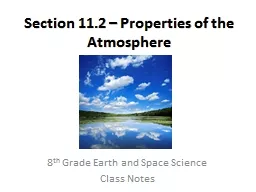

Section 112 Properties of the Atmosphere 8 th Grade Earth and Space Science Class Notes Temperature Temperature measure of the average kinetic energy of the particles in a material Higher the temperature faster particle movement ID: 765885
Download Presentation The PPT/PDF document "Section 11.2 – Properties of the Atmos..." is the property of its rightful owner. Permission is granted to download and print the materials on this web site for personal, non-commercial use only, and to display it on your personal computer provided you do not modify the materials and that you retain all copyright notices contained in the materials. By downloading content from our website, you accept the terms of this agreement.
Section 11.2 – Properties of the Atmosphere 8th Grade Earth and Space ScienceClass Notes
Temperature Temperature – measure of the average kinetic energy of the particles in a materialHigher the temperature = faster particle movement
Air Pressure The Earth’s atmosphere exerts a downward force due to the weight of the atmosphere. Air pressure – pressure exerted on a surface by the weight of the atmosphere Units – N/m 2 or mb (1 mb = 100 N/m 2 ) The higher you go in the atmosphere the less air pressure.
Density of Air Density of air decreases with increasing altitude because the molecules are further apart.Near sea level density is 1.2 kg/m 3
Pressure-Temperature-Density Relationship In the atmosphere, the temperature, pressure, and density of air are related.
Air Pressure and Temperature Warmer air = higher pressureParticles move faster and exert a greater force
Air Pressure and Density At the same temperature, air with higher density exerts more pressure than air with lower density.More gas particles means more collisions.
Temperature and Density At the same pressure, warmer air is less dense than cooler air.Heat causes particles to move faster and spread apart.
Temperature Inversion Increase in temperature with height in an atmospheric layer
Cause and Effects of Temperature Inversion Land is not radiating thermal energy to lower layers of atmosphereExample – cold, clear winter night when air is calm Leads to fog, low-level clouds, and trapping pollutants close to the Earth’s surface
Wind Wind – movement of air; caused by cold, dense air rushing towards warm, less dense air
Wind and Pressure Difference Air moves from regions of higher density to areas of lower densityAir pressure increases as density increases, so air moves from areas of high pressure to low pressure as well
Wind Speed and Altitude Wind moves slower near the Earth’s surface due to frictionWind speed is measured in:Miles per hour (mph)Kilometers per hour (km/h)At sea – in knots (1 knot = 1.85 km/h)
Humidity Humidity – amount of water vapor in the atmosphere at a given locationTwo ways to express – relative humidity and dew point
Relative Humidity Water molecules are constantly evaporating into the atmosphere and condensing to form clouds and precipitation.If rate of evaporation > rate of condensation then the amount of water vapor increases Relative humidity – amount of water vapor needed for a volume of air to reach saturation Saturation – amount of water vapor in the air is at its max Relative humidity is expressed as a percentage (100% when fully saturated)
Dew Point Temperature to which air must be cooled at a constant pressure to reach saturationIf dew point is close to the air temperature then the relative humidity is high
Latent Heat As water vapor in the air condenses thermal energy is released as latent heat.
Condensation Level A process in which temperature changes without the addition or removal of thermal energy from a system is called an adiabatic process. Adiabatic heating occurs when air is compressed, and adiabatic cooling occurs when air expands.
Condensation Level At equilibrium, evaporation and condensation occur at equal rates, so the amount of water in the liquid form remains constant.Condensation occurs at the lifted condensation level (LCL). Air above the LCL is saturated and thus cools more slowly than air below the LCL.